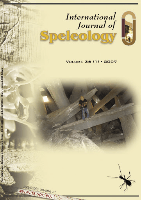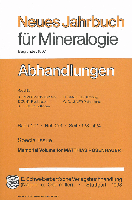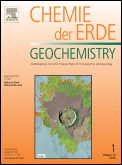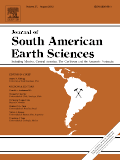
INTERNATIONAL JOURNAL OF SPELEOLOGY
Scope & Guideline
Unveiling Subterranean Secrets Through Research
Introduction
Aims and Scopes
- Hypogene and Sulfuric Acid Speleogenesis:
The journal extensively publishes studies on hypogene speleogenesis, which refers to cave formation processes driven by deep-seated fluids, particularly in carbonate rocks. This includes research on sulfuric acid speleogenesis, which explores how sulfuric acid contributes to cave development and geomorphology. - Geochemical and Isotopic Analyses:
A significant focus is placed on geochemical processes within caves, employing isotopic analyses (e.g., stable isotopes, clumped isotopes) to understand past climates, cave formation, and mineral deposits. This is crucial for reconstructing paleoenvironmental conditions. - Cave Ecology and Biodiversity:
The journal highlights the ecological aspects of caves, including studies on cave-dwelling organisms, their adaptations, and biodiversity. This research is vital for understanding the ecological significance of caves and their conservation. - Karst Hydrology and Hydrogeology:
Research on karst hydrology, including water flow dynamics and aquifer characteristics, is a core area. This includes studies on the interactions between surface and subsurface water systems and their implications for karst management. - Technological Applications in Speleology:
The incorporation of technology in cave studies, such as digital modeling, monitoring air fluxes, and using artificial tracers, represents a growing methodological approach. These technologies enhance the understanding of cave environments and their dynamics.
Trending and Emerging
- Climate Change Impacts on Cave Systems:
There is an increasing focus on how climate change affects cave environments, including studies on temperature variations, CO2 levels, and their implications for cave ecosystems and mineral deposits. Understanding these impacts is crucial for conservation and management. - Interdisciplinary Approaches to Speleogenesis:
Recent works emphasize interdisciplinary methodologies that combine geology, hydrology, and biology to explore speleogenesis. This trend reflects a broader understanding of cave systems as complex, interconnected environments. - Technological Advances in Cave Research:
The application of advanced technologies, such as digital modeling and isotopic analysis, is on the rise. These methods enhance the precision of cave studies and facilitate new discoveries related to cave formation and environmental monitoring. - Paleoenvironmental Reconstructions:
There is a growing interest in using cave deposits (like speleothems and guano) to reconstruct past environmental conditions. This research is crucial for understanding historical climate variations and their effects on cave systems. - Conservation and Management of Cave Ecosystems:
With increasing awareness of biodiversity loss, there is a notable emphasis on the conservation of cave ecosystems. Research addressing anthropogenic impacts and proposing management strategies is becoming more prevalent.
Declining or Waning
- Traditional Speleological Techniques:
There appears to be a decrease in publications focusing solely on traditional speleological mapping and exploration methods. As new technologies and interdisciplinary approaches gain traction, the emphasis on conventional techniques is diminishing. - Generalized Biodiversity Studies:
Although cave biodiversity remains important, the trend indicates fewer generalized studies on cave organisms and more specific investigations into unique species or ecosystems. This shift may reflect a move toward more targeted research questions. - Historical and Anthropological Studies:
Research exploring the historical and anthropological aspects of caves, such as human uses and cultural significance, has become less frequent. This may signal a shift towards more scientific and ecological inquiries over cultural studies.
Similar Journals

Journal of Paleolithic Archaeology
Discovering the Rich Tapestry of Prehistoric LifeJournal of Paleolithic Archaeology, published by SpringerNature, stands at the forefront of scholarly research in the field of archaeology, focusing specifically on the rich and complex narratives of human prehistory. With an E-ISSN of 2520-8217, this engaging journal serves as a vital resource for researchers, professionals, and students alike, offering open-access articles that disseminate groundbreaking discoveries and theoretical advancements in Paleolithic studies. The journal's objective is to foster a deeper understanding of early human culture, technology, and the environment, ensuring accessibility to vital knowledge that shapes our understanding of human evolution. As the field of archaeology continues to evolve with innovative methodologies and interdisciplinary approaches, the Journal of Paleolithic Archaeology emerges as an essential platform for sharing insights and fostering a vibrant academic community dedicated to unraveling the mysteries of our ancient past.

NEUES JAHRBUCH FUR MINERALOGIE-ABHANDLUNGEN
Documenting the evolution of mineralogical research.NEUES JAHRBUCH FUR MINERALOGIE-ABHANDLUNGEN, published by E Schweizerbart'sche Verlagsbuchhandlung in Germany, is a distinguished scholarly journal dedicated to advancing the fields of mineralogy and petrology. With an ISSN of 0077-7757, it provides a platform for researchers to disseminate high-quality findings that contribute to our understanding of Earth sciences. Although it currently has no open access options, the journal remains vital for professionals seeking to engage with impactful research in geochemistry and petrology, as reflected in its 2023 Scopus ranking in the 21st percentile within its category. The journal has documented significant research from 1980 to 1988 and resumed from 1996 to 2023, making it a crucial archive for historical and contemporary studies. Despite its current Q4 quartile ranking, NEUES JAHRBUCH FUR MINERALOGIE-ABHANDLUNGEN is an important contributor to the academic discourse in its field, and it invites researchers, professionals, and students alike to explore and submit their work that drives innovation and understanding in mineralogical studies.

CARBONATES AND EVAPORITES
Elevating Understanding of Essential Geological MineralsCARBONATES AND EVAPORITES is a distinguished peer-reviewed journal published by Springer, with a dedicated focus on the geochemical and petrological aspects of carbonates and evaporite minerals. Since its inception in 1986, the journal has served as a vital platform for disseminating high-quality research, contributing significantly to the understanding of these essential geological formations. With an impressive Scopus ranking in the 49th percentile and categorized in the Q3 quartile for Geochemistry and Petrology in 2023, it stands as a credible source for both researchers and professionals in the field. The journal is committed to publishing original research articles, reviews, and technical notes that enhance knowledge and foster discussion in the community. Although not an open-access publication, it continues to provide critical insights and findings that influence advancements in Earth and planetary sciences. Operating from its base in Germany, the journal is poised for continued relevance as it approaches the convergence year of 2024, inviting contributions that explore the richness of carbonate and evaporite studies.

Carpathian Journal of Earth and Environmental Sciences
Championing High-Quality Research in Earth SciencesCarpathian Journal of Earth and Environmental Sciences is a distinguished academic journal dedicated to advancing the interdisciplinary field of Earth and environmental sciences. Published by the Carpathian Association for Environment and Earth Sciences, this journal plays a pivotal role in disseminating high-quality research focused on the dynamic interactions between geological processes and environmental changes. With an ISSN of 1842-4090 and an E-ISSN of 1844-489X, the journal is indexed in Scopus and holds an esteemed Q3 quartile ranking in both Earth and Planetary Sciences and Environmental Science categories as of 2023. Since its inception in 2008, the Carpathian Journal has provided an open access platform for researchers, professionals, and students to share insights, foster collaboration, and engage in critical discussions on pressing environmental issues. By continuously contributing to the body of knowledge in this field, the journal not only enhances academic discourse but also promotes sustainable environmental practices across Romania and beyond.

Geosphere
Illuminating the Path of Geological Discovery and CollaborationGeosphere is a premier open access journal published by the Geological Society of America, Inc., dedicated to advancing the fields of geology and stratigraphy. Since its inception in 2005, this journal has established itself as a critical platform for sharing high-quality research, evidenced by its robust positioning in the 2023 Scopus rankings, where it holds the 12th rank in stratigraphy and 75th in geology. With an impressive impact factor and a commitment to open access since 2018, Geosphere facilitates the dissemination of significant findings to a global audience, making it an essential resource for researchers, professionals, and students alike. The journal's scope includes a wide range of topics related to Earth and Planetary Sciences, encouraging interdisciplinary collaboration and innovation. Based in the United States, Geosphere continues to foster a community dedicated to understanding the Earth's processes and resources, ensuring that it remains at the forefront of geological research.

Geochemistry
Fostering Academic Excellence in GeochemistryGeochemistry is a distinguished academic journal published by Elsevier GmbH, focusing on the intricate study of geochemical processes across earth systems. With its ISSN 0009-2819 and E-ISSN 1611-5864, this journal serves as a crucial platform for scholars and researchers eager to disseminate their latest findings in geochemistry, petrology, and geophysics. The journal has established itself within the scientific community, achieving a Q2 ranking in both Geochemistry and Petrology as well as Geophysics, showcasing its significant impact and relevance—ranking 18th out of 165 in Geophysics and 26th out of 154 in Geochemistry and Petrology according to Scopus. From its inception in 1978 to its ongoing contributions through 2024, Geochemistry remains a vital resource for academic discourse and innovation in earth sciences. As an open-access title, it allows for broader dissemination of knowledge, promoting accessibility for researchers, students, and professionals. Whether you are engaged in theoretical research or applied studies, Geochemistry provides the insights necessary to advance our understanding of the planet's chemical complexity.

JOURNAL OF SOUTH AMERICAN EARTH SCIENCES
Fostering Insights into Earth's Dynamic ProcessesJOURNAL OF SOUTH AMERICAN EARTH SCIENCES is a premier interdisciplinary journal dedicated to publishing high-quality research in the fields of Earth-Surface Processes, Geology, and Paleontology, making it an essential resource for scientists and researchers focused on South American geology and its diverse geological phenomena. Published by Pergamon-Elsevier Science Ltd in the United Kingdom, this journal has been instrumental in disseminating groundbreaking studies since 1988, showcasing contributions that push the boundaries of knowledge in Earth and Planetary Sciences. With an impressive Scopus ranking—positioning it in the 74th percentile for Paleontology and 71st for Geology—this journal not only reflects robust academic quality but also its commitment to addressing critical geological challenges in South America. Researchers will appreciate its objective of advancing understanding of geological processes while providing insights into past, present, and future Earth environments. Although available through traditional subscription models, the journal's vast repository of articles enriches the academic landscape, facilitating the sharing of vital research among professionals, students, and geological practitioners.

BOLETIN GEOLOGICO Y MINERO
Uncovering Earth's Secrets, One Study at a TimeBOLETIN GEOLOGICO Y MINERO is a significant academic journal published by the Instituto Geológico Minero de España, focusing on the fields of Geology and Geochemistry. Established in 1980, this journal provides a platform for researchers to disseminate vital studies and findings in the earth sciences, encompassing an array of topics from mineralogy to environmental geology. Despite its Q4 ranking in both Geochemistry and Petrology and Geology categories as of 2023, the journal serves as a resource for emerging research and innovative methodologies in these critical fields, promoting a deeper understanding of geological processes and materials. While currently operating without an open-access model, the journal is committed to advancing knowledge through rigorous peer-review standards. With its roots in Spain, the BOLETIN GEOLOGICO Y MINERO significantly contributes to the European geological research community and remains an invaluable resource for students, professionals, and researchers alike engaged in the pursuit of geological science.

Mineralogical Journal-Ukraine
Unlocking the mysteries of minerals and earth sciences.Mineralogical Journal-Ukraine is a key academic publication dedicated to advancing the field of mineralogy and geochemistry, under the esteemed auspices of the M.P. Semenenko Institute of Geochemistry, Mineralogy & Ore Formation of NAS Ukraine. Since its inception in 2019, this journal has established itself as an essential resource for researchers and professionals engaged in the study of energy, fuel technology, and the earth sciences, despite its present rankings reflecting a developing impact within these specific categories on Scopus. Published in Ukrainian and available in both print and online formats, the journal not only aims to disseminate high-quality research but also encourages inclusive access to vital findings in mineral exploration, petrology, and geochemical processes. With a commitment to excellence and an expanding scope of research, Mineralogical Journal-Ukraine stands as a pivotal platform for innovation and collaboration among scientists striving to understand the complexities of mineral formation and ore deposits.

GEO-MARINE LETTERS
Innovating Insights for a Sustainable Marine FutureGEO-MARINE LETTERS, published by Springer, is a prestigious academic journal that has been a pivotal platform for the dissemination of innovative research in the fields of Earth and Planetary Sciences, Oceanography, Environmental Science, and Geotechnical Engineering since its inception in 1981. With an E-ISSN of 1432-1157, this journal has established itself in the Q2 quartile across multiple categories in 2023, indicating its influential position within the scientific community, as reflected by its Scopus rankings. While it currently does not offer an open access option, its rigorous peer-review process ensures the publication of high-quality research that contributes significantly to advancing our understanding of marine and geological sciences. Researchers, professionals, and students alike will benefit from the diverse scope of studies featured in GEO-MARINE LETTERS, making it an essential resource for those engaged in environmental and marine research. Situated in Germany, the journal's commitment to excellence continues to shape critical discussions and innovations in the field.